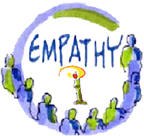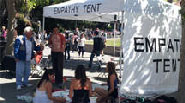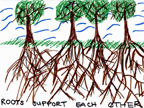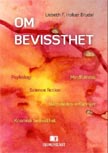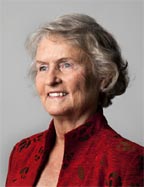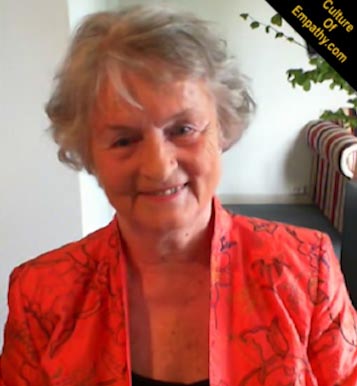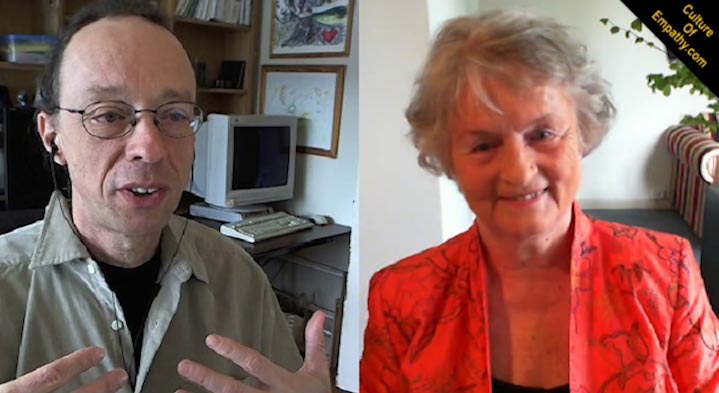|
|
|
Culture of Empathy
Builder: Lisbeth Holter Brudal
Lisbeth
Holter Brudal & Edwin Rutsch: Dialogs on How to Build a Culture of Empathy
in Norway
Lisbeth has developed courses in Empathic Communication. One
course (20 hours) for professionals who want to use Empathic Communication
in their work and one course (40 hours) for trainers in the method.
The trainers
give the 20-hours courses, one-day seminars introducing the method,
participate in different congresses about education and also give
lectures about Empathic Communication at different university colleges.
The trainers also learn during the 40-hours course how to educate other
trainers. Empathic Communication, as a method, has been presented on
Norwegian TV. Lisbeth
Holter Brudal:
Trainer:
Anne Gro Tvedt:
Trainers: Ronny & Katrine Yttrehus:
Website:
LisbethHolterBrudal.com
Online Curriculum Lisbeth Holter
Brudal & Edwin Rutsch: Dialogs on How to Build a Culture of Empathy in
Norway
Anne Gro Tvedt:
Empathic Communication Process - Introduction & Overview -
Part
2
Ronny &
Katrine Yttrehus & Edwin Rutsch: Dialogs on How to Build a Culture of
Empathy
Ronny & Katrine Yttrehus are ministers in Oslo, Norway and
have been taking the 20 hour Empathic Communication Training with
Lisbeth Holter Brudal. They will also take
the 40 hour trainer course. They talked about their experience taking
the training and why they want to be trainers in empathic communication?
A group of members in their congregation will take the
training and they would like to make there
church an empathic congregation.. Ronny says there's a lot
of loneliness in Norway and they want to address that.
Transcripts
00:00 Introduction
(transcription pending)
(Video
Transcriptions: If you would like to take empathic action
and create a transcription of this video, check
the volunteers page. The transcriptions will make it easier for
other viewers to quickly see the content of this video.)
Empathic
Communication: The Missing Link This
is a book about empathy and communication. Empathy - the ability to
recognize other people's feelings and intentions - is an innate ability.
To communicate - to participate in dialogue, seek contact, and engage in
interaction with others - is an innate need.
There is strong evidence that the ability to empathize is
partially linked to a specific type of nerve cells in the brain. These
cells are called "mirror neurons". Neurobiological research shows that the
mirror neuron system makes it possible for us to replicate and recognize
other people's feelings and intentions. The cells also affect our capacity
for self-reflection.
The innate potential for empathy in a human being can
be developed early in a human being through the caregiver's ability to
communicate, build a relationship, and meet the child's inner need for
contact.
The book describes a special communication tool, empathic
communication, built on the understanding of communication which is
described above.
TABLE OF CONTENTS CHAPTER 1
CHAPTER 4:
RELATIONAL SKILLS AND EMPATHIC COMMUNICATION CHAPTER 5:
EXPERIENCES FROM COURSE WORK AND LECTURES CHAPTER 6
PROPOSAL FOR A SEVEN-DAY COURSE PROGRAM IN EMPATHIC COMMUNICATION
Empathy Circle Development: Lisbeth, Ronny, Edwin, Sherry: 2013-02-19
Empathic Communication: "John"
Presented several papers in four Scandinavian countries, England and USA (San Francisco). Born in 1935 in Oslo. Married to a psychologist. Two children and five grandchildren. Still working as a psychologist. This autumn in 2012 I shall, among other things, educate 12 new instructors in “Empathic communication” , probably some coming from Denmark and Sweden, giving a one day seminar in “Empathic communication for a group of 25 persons working in the public health service. I shall also lecture in the autumn about “Empathic communication” on a large congress north in Norway for 250 professionals from different institutions working with children and their families. Some of my colleagues and instructors in the method have similar tasks for the autumn in spreading the knowledge and importance of developing “Empathic communication”.
Short information: I am retirement pensioner after being director of
Institute of Tocology and Family pschology for many years.. (Tocology.
The science of birth/delivery from gr.) I founded the Institute in 1985
after being assistant professor at The Institute of Psychology at the
University of Oslo for several years. “Empatic communication” as a
method is a result of experiences in my therapeutic work as a
psychologist.
================================================
Scientific background
I will show you on Skype a simple figure which is the core of our
work. I enclose the figure. Our clients – being a cancer patient, a
women who has lost her child, a man who consider suicide – are in what
we call a Frontier zone. They have left their Everyday state of mind
and in this new landscape we know that their affections, cognition,
perception, body image and consciousness are influenced. So how do we
communicate with a person in Frontier zone to help him re-establish his
Everyday state and psychological balance? One way is to invite the clients to participate in empathic communication. This is a process which may be described by the most often defined metaphor for empathy: “standing in someone elses shoes”. In this process our
first aim is to try to know another persons internal state including
thoughts and feeling. We are in his shoes. The program consist of four steps.
1. Tell us his story
We invite the client to tell us his story, to express what he see as the
main problem, what is his subjective experience of the situation – and
not what he has been told about the situation. We are looking for the
clients own narrative.
During this three steps – when we try to find out “where the client is” and when we are in his shoes – it is important not interrupt, correct or comment on what we learn from the clients narrative or what kind of feelings and reflections the clients inform us about. We just listen in a state of mindfulness. Then we turn to the next step and the process is developing further.
4.
Here we are back in our own shoes and ask
the client if he would like to hear our opinion about what he has told
us about the situation, about his feelings and reflections. The roles
are changed - at this step the client is encouraged to listen to us.
We are co-creators. By giving our comments to what we have heard
and sharing our professional competence we empathize with the client
and may create a new internal state in him - helping him moving back to
the Everyday state. In this empathic atmosphere we are mirroring the
clients narrative, feelings and reflections by giving back to him what
we have heard and at the same time we present ourself and make us self
visible from an existential point of view. In this creative part of the
process we may experience “ moments of meeting” between the client and
our self. In this way we are changemakers. “Empathic
communication” as a method is presented also on internet.
The internet program starts with an introduction of the method by dr. Jardar Hals and a demonstration of a empathic meeting between a mother of child with cancer and a nurse. Each of this six sessions is ca. 10 min. long.
================================================
Outline of Empathic Communication Empathic communication is a method consisting of a dialog of four steps. During the three first steps the helpers listen to and focus on:
The method is developed by dr. philos., specialist in clinical psychology Lisbeth Holter Brudal, Norway. The method is based on Aaron Antonovskys theory about the importance of sense of coherence for our psychic health (SOC). This coherence consists of three components: a feeling of understanding – a feeling of manageability – a feeling of meaning in ones life. During illness, crises and stress this coherence might be impaired. The individual may find himself in “Frontier zone” and removed from his “Everyday state”. The aim of empathic communication is – through the dialog – to build a new experience of coherence in the life of the client including a new understanding and a new feeling of manageability and meaning. As part of supervision and dialogs within organizations the aim of empathic communication is to strengthen and develop the individuals sense of coherence, their feeling of understanding, manageability and meaning in life. The essential condition to obtain these aims is that the helpers have the necessary competence in dealing with relationships in a professional setting (relational skill). The theoretical foundation for empathic communication is:
The following courses in empathic communication are on offer:
Literature on empathic communication:
Curriculum: Empathic
Communication
Table of Contents
Introduction
“The Art of Helping Others to Understand” This is the secret in the entire art of helping. Anyone who cannot do this is himself under a delusion if he thinks he is able to help someone else. In order truly to help someone else, I must understand more than he – but certainly first and foremost understand what he understands. If I do not do that, then my greater understanding does not help him at all. If I nevertheless want to assert my greater understanding, then it is because I am vain or proud, then basically instead of benefiting him I really want to be admired by him. But all true help begins with a humble attitude. The helper must first humble himself under the person he wants to help and thereby understand that to help is not to dominate but to serve, that to help is not to be the most dominating but the most patient, that to help is a willingness for the time being to put up with being in the wrong and not understanding what the other understands.
“Learning by doing”
“Frontier zone”
The Helper The course consists of a presentation of the theoretical and empirical fundament for empathic communication. The definition of empathy is: A process which makes it possible to look at a situation from another persons point of view and also recognize his feelings, norms, values and apprehensions. Further the course focuses on how to practice the method. The helpers practice in groups. It is recommended that the helpers also practice empathic communication in between the sessions – at work, together with friends or family members. The experiences from the practicing processes are discussed with the trainer and group members in plenum and analyzed in relation to the psychological theories. A governing idea in the recommendation of Kierkegaard is that the first task in helping another person is to “take care to find him where he is and begin there”. To learn to know the other person is a presupposition for helping and a condition for the clients to attain the helpers “greater understanding”. It is when this aim is obtained that it is possible to “succeed in leading a person to a specific place”, maintains Kierkegaard.
The four steps
According to the definition of the relationship we may say that step four represents the beginning of the “creation of new realities through free exchange of ideas and views” (Positive psychology – focus on creativity and resources). By means of the co-creation-process the helper is able to lead the client to a “specific place”- which is his “Everyday state”- where he may experience a new and strengthened “sense of coherence” (SOC). This sense represents an new understanding of his own situation, a feeling of manageability and meaning of life ( See A. Antonovsky (1987): Unraveling the Mystery of Health – theory of SOC). Some clients find that after they have experienced empathic communication they also want to practice the method on themselves. This “empathic self observation” in for steps is described in my book Positive psychology, 2006.
One important aim for the trainers work is to develop empathy and relational skills amongst the helpers. The trainer must arrange for optimal situations for practicing in groups. The size of the course and practical conditions determine the size of each training group. It is the trainers responsibility to present different examples of cases for role-playing in the training groups (arranged situations or real cases). The participants swop between playing the role of the client, the role of helper or the observing role. After each training session the participants meet in plenum to share their experiences and reflect upon the process and their relational skills. The trainer is the leader of this plenum session and has the responsibility of collecting the participants experiences throughout the four steps referred to above. Research suggests that the trainers own empathy and relational skills is of importance for the learning process. Each course is arranged in accordance with the participants interests, place of work, motivation and expectations. The Norwegian internet film : www.helsefilm.no present different examples of situations for using empathic communication (nurse – relative, psychotherapist – client, supervisor – health personal I difficult work situations, teacher – pupil, leader – employee). In introducing the course the trainer informs about the Norwegian law (2.7.1999) concerning patients rights (“Pasientrettighetsloven”). The law says that all patients have the right to cooperate in the treatment and to get information about their situation. Empathic communication is in accordance with this law: We invite the patients to cooperate and we offer our information. To be certificated as a trainer one is supposed to present a short essay with relevance for empathic communication.
Empathic Communication in Practice When the helper has completed the 40 hours course he/she is qualified to lead courses in empathic communication for professionals within various of the above mentioned fields. The following courses in empathic communication are on offer: Introduction course 1- 5 hours. Advanced course 15 -20 hours. Training course 30 – 40 hours. Here is an example of two models for developing empathic communication in the society.
The
Stavanger model A follow up 18 months after the 40 hours training course shows that the center in Stavanger has implemented the method as an ongoing routine.
The Drammen model This core group was responsible for educating other professionals in the hospital in empathic communication (nurses, doctors, midwifes and office staff). In the training period in all 78 employees was educated by the core group. An important new routine was developed as a result of the training: The after delivery talk. Today parents at Drammen hospital is offered an empathic communication dialog before they leave the hospital. The experience today – after many years of practice – is that by means of the after delivery talk and empathic communication the midwifes and doctors have the possibility to detect and prevent post partum depression. Today different wards in the hospital use empathic communication daily in different connections: in relation to patients, in team work, in supervision, in leadership and in educating students. In special and complicated situations in their work midwifes have during the years adopted a general motto for solving a problem: “We do it the Brudal way”! In 2005 and 2006 the Child clinic in the same hospital completed a 40 hours training program for nurses and doctors.
Generally In the autumn 2012 I will give a lecture on empathic communication at a congress of 250 health personal in the north of Norway and a day information course for 25 health personal in a hospital south of Oslo. I will also accomplish a training course for members and ministers of The International Churches of Christ in Oslo this autumn.
Five Lessons We invite the participants to a course where the motto is “Learning by doing”.
First
lesson.
Second lesson.
Third lesson.
Fourth lesson.
Fifth lesson.
Training in groups.
Literature.
Empathic communication is a realization of S. Kierkegaard`s paragraph “The Art of Helping Others to Understand”. The results from our evaluation programs indicate that most participants who have attained courses in empathic communication consider the method as a valuable component in their work, especially in difficult situations. Several experience that empathic communication is a useful tool which strengthens their feeling of manageability. The participants all confirm the advantage of “learning by doing” which is a central principle in the courses. The participants report that their clients appreciate empathic communication to a great extent. They tell that to be affirmed and to be seen, to be accepted and respected during empathic communication is of great importance. It is also confirmed that to use empathic communication in a workplace to not require more time or cost than the “old way of communication”. Experiences since 2004 suggest that empathic communication may be an important tool for detecting and preventing post partum depression. An example is empathic communication as an after delivery talk. In addition it seems that empathic communication may represent a meaningful component in the treatment of patients with cancer.
The results referred to regard the Stavanger and the
Drammen model indicate that it may be possible – by means of courses in
empathic communication – to develop a culture of empathy.
However I will now suggest the following after discussing the matter
with my trainers.
|
||||||||||||||||||||||||||||||||||
|
||||
